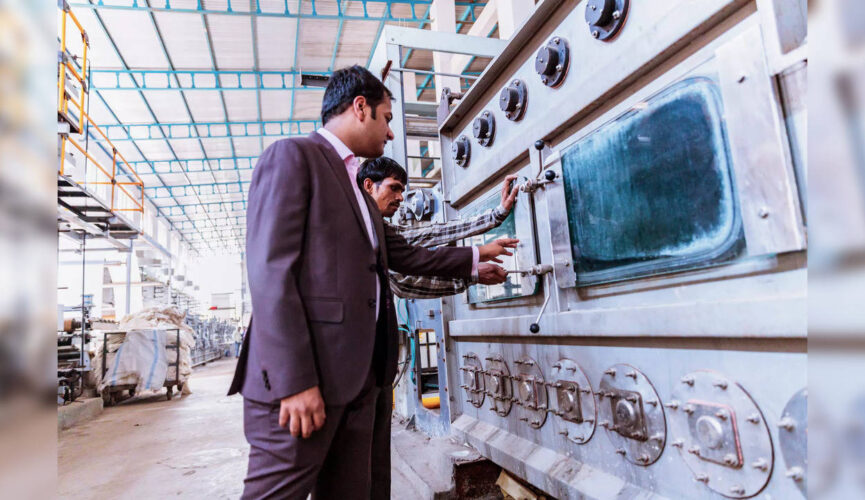Task Force Labor tends to earn higher salaries than in other industries. Workers who leave the sector do so for better opportunities, such as administrative and support services or construction.
Despite declining output, the manufacturing sector remains important to Eighth District economies. Its share of overall output is larger than national averages, and the industry contributes a greater percentage to Eighth District GDPs.

Modern manufacturers are looking for workers who are skilled in a variety of areas. Manufacturing work can vary greatly from day to day, so workers need to be able to think on their feet and solve problems quickly. It’s also important for manufacturing workers to stay up to date on any new technology or equipment that might be introduced into the workplace.
One of the most important skills that manufacturing workers require is attention to detail. This is important because production environments are typically filled with large machinery, and any lapse in concentration could cause injury or even death. In addition, attention to detail is necessary when working with dangerous materials.
Another essential skill for manufacturing workers is the ability to be flexible in the face of unexpected challenges. For example, if equipment breaks down or there is a sudden change in demand, workers must be able to adapt and adjust their schedules accordingly. They should also be able to learn new skills and take on different tasks as needed.
A third important skill for manufacturing workers is the ability to work well in a team environment. This is especially important in manufacturing, where employees must collaborate with each other to produce quality products. Having good communication skills is crucial in manufacturing, as it helps ensure that all members of the team are aware of what needs to be done and when.
Lastly, it’s important for manufacturing workers to be able to use basic math and analytical thinking skills to understand how their work affects the overall product. This is important because it allows them to make informed decisions about how they can improve the company’s processes and products.
Manufacturing remains a crucial industry, and it’s imperative that manufacturers continue to recruit the best possible talent for their jobs. This will help to avoid a labor shortage that has plagued the industry for years, and it’ll also help companies compete in a global marketplace.
With the COVID-19 pandemic waning, now is an ideal time to explore career opportunities in the manufacturing sector. The skills shortage that has impacted the industry for so long should start to ease, and there are numerous opportunities available for qualified candidates.
In the past, a high school dropout could still find a job in manufacturing. Today, workers in the industry need a strong mix of education and training, including postsecondary certificate or degree programs and on-the-job apprenticeships.
Manufacturers have a variety of workforce development strategies to attract and retain qualified applicants, including providing a robust menu of work/life benefits, such as flexible schedules and paid vacation time, as well as competitive wages. Additionally, manufacturers can partner with community colleges and technical schools to offer customized training programs tailored to their needs and the specific skills they require.
As the economy recovers and the COVID-19 pandemic ends, more Americans will consider manufacturing jobs. In the midst of a growing skills gap, manufacturing employers need to continue to invest in their workforce and promote their career opportunities in ways that are engaging for current and prospective employees.
While many manufacturers struggle to attract and retain skilled labor, some are bucking the trend with innovative initiatives that focus on a high-tech future and offer compelling incentives for young people to join the manufacturing sector. These include launching apprenticeship programs that provide on-the-job learning and training while providing a pathway for advancement into management roles. Some also are investing in advanced technologies, such as robotics and machine learning, which can help to solve many complex problems on the factory floor that currently require human oversight.
Other important factors that manufacturers must consider when developing workforce solutions for their individual needs are local demographics and prevailing socioeconomic conditions in their communities. For example, some areas of the country have a higher concentration of skilled tradespeople who have specialized training in fields such as CNC machining and welding, or in engineering disciplines such as mechatronics and CAD/CAM software. This can create a natural pool of talent from which to recruit, especially if manufacturers align their training programs with the needs of these populations.. Census Bureau’s Job-to-Job Flows Explorer data tool shows that those who change jobs often move into other industries that require the same or similar skills sets, such as administrative and support services and construction.
Manufacturing is an industry that requires a lot of hands-on work. This means that experience is a big plus when it comes to applying for and landing the right job. Some entry-level positions in manufacturing don’t necessarily require prior experience, but those with more substantial skills sets are generally preferred. The good news is that many of the skills you develop in this industry are transferable. If you’ve worked in retail or office environments, or have educational experiences in high school or college, you may already have some valuable skill set that qualifies as manufacturing experience. Additionally, any type of machine or equipment operation or warehouse tasks can qualify as “manufacturing experience.”
The skills that you’ll need to acquire in order to find a manufacturing position vary depending on the specific occupation. You can find a comprehensive list of occupations and their qualifications in the Occupational Outlook Handbook. This resource can help you learn more about the specific requirements for a manufacturing job, including education and training.
In general, a manufacturing position will require you to have strong attention to detail and be able to follow a strict production schedule. You’ll also need excellent communication skills to solve any problems that arise on the job. Since many manufacturing workers are required to handle hazardous materials or work in tight spaces, it’s important that they can remain focused for extended periods of time and are able to manage the stress of working under pressure.
Manufacturers are having a hard time finding workers, especially in the skilled trades. As a result, some employers have resorted to offering retention incentives. These perks can include flex schedules, paid vacation, and family events. Moreover, these incentives are designed to encourage employees to stick around and continue producing quality goods for the company.
One way to expedite your search for a manufacturing job is by partnering with a staffing agency. These agencies can connect you to unadvertised positions and identify skill-building temporary jobs that will prepare you for permanent opportunities in the future. Plus, they can offer you the opportunity to earn competitive wages while you’re developing your manufacturing skills.
Manufacturing employment peaked in 1979 and has been declining since, with the sector losing a million jobs during the Great Recession (and another 11.4 million during the COVID-19 shutdowns). In recent years, increasing trade tensions and global supply chain disruptions have led manufacturers to reconsider shifting back to domestic production.
Many workers in the sector are nearing retirement age and may not have the skills to shift to other sectors, a factor that could slow the recovery from a labor shortage. The Brookings Institution reports that men with high school educations who were employed in the manufacturing industry lost more than half of their jobs between 1980 and 2017. Meanwhile, women with a college degree largely avoided losing manufacturing employment, but still saw significant job loss.
As the manufacturing labor force shrinks, a growing number of firms are offering incentives to retain skilled older workers. These include flex schedules, paid vacation time, family events and competitive pay, as well as apprenticeship programs at local community or technical colleges. Many companies also are organizing plant tours and open houses to boost public visibility of their work and promote their attractive employee benefits.
The manufacturing sector’s future outlook depends on how well it can overcome a shortage of younger workers. The sector has performed comparatively well during the pandemic, and its growth prospects are stronger than those of the service sector. However, its future may be hampered by the fact that it relies on younger workers for its higher productivity levels.
In addition, the decline of the manufacturing sector has implications for local communities that developed as industrial hubs. The sector’s disappearance can deprive these communities of a major source of employment, and policies should facilitate reskilling for those displaced and reduce the costs of sectoral reallocation.
The future of the manufacturing workforce will be shaped by factors that affect both the supply and demand for skilled workers, including demographics, education, skills, and wages. As the manufacturing workforce evolves, policymakers will need to develop new strategies for building a stronger, more inclusive economy. To do so, they should encourage innovation in the sector, support industry-wide collaborations, and improve training and education systems for both employers and workers.

